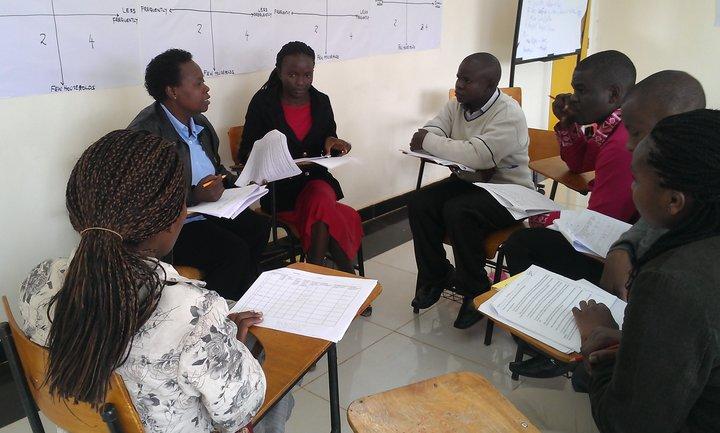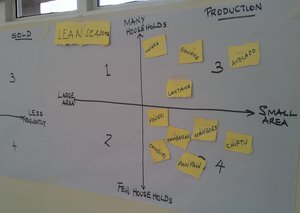How communities in Kenya are putting nutritious diversity back on the plate

Part 1 of three special reports from Vihiga County, Kenya, where a research initiative is empowering the community to better use available agricultural biodiversity to improve nutrition all the year round.
Part 1 of three special reports from Vihiga County, Kenya, where a research initiative is empowering the community to better use available agricultural biodiversity to improve nutrition all the year round.
Francis Odhiambo, Research Assistant, Bioversity International reports:
What is the research you are working on?
In August 2014, Bioversity International launched a research project ’A Participatory approach to improve dietary diversity in Vihiga County’, part of the CGIAR Research Program on Integrated Systems for the Humidtropics. The project supports communities to develop, implement and monitor their own action plans for sustainable production of nutritious foods to improve dietary diversity for families, focusing on the special nutritional needs of women and young children. It also considers food diversity that is available in the wild and at the market.
Why is this important?
With the global population expected to exceed 9 billion by 2050 and an estimated 795 million people suffering from insecure food supplies, poor access to foods, and nutritionally inadequate diets, the global population faces a double challenge – to produce enough nutritious food for everyone while conserving the environment and ecosystems to ensure food production for future generations. Many research and development organizations and governments have shifted focus to find innovative ideas so that no one goes to bed hungry or malnourished – a mission we share at Bioversity International.
Why are you focusing on Vihiga County?
Vihiga County is one of the counties in Kenya with high levels of malnutrition, despite being endowed with a rich biodiversity. Diets, mainly based on maize as a staple, remain poor in diversity and often do not meet minimum requirements for several micro-nutrients. Vihiga is part of the Humidtropics CGIAR Research Program action site in Western Kenya so it is an ideal location to study and increase the use of agricultural biodiversity for dietary diversity and quality.
 How is the research being put into action?
How is the research being put into action?
Our project follows the participatory paradigm. Participatory research methods have been proven effective for promoting positive change in a variety of contexts, including agriculture, nutrition and health settings. However, there are still a lot of knowledge gaps on how participatory community work can improve diets. We are implementing the project in three phases. Phase I, the diagnostic phase, involved collection of primary data on the knowledge, attitudes and practices on nutrition and the available biodiversity both at the household and community levels. We collected data on dietary diversity and nutrient intakes of women of reproductive age and young children aged 12-23 months across two seasons coinciding with the lean season and the season of plenty. Phase II is currently on-going and involves 6 workshops to disseminate the results collected so far to the community and work with them to identify interventions to improve nutrition that will be implemented in Phase III of the project beginning later this year.
What are the findings so far?
We have four main findings to talk about. First is that Vihiga County is very rich in biodiversity, both wild and cultivated or domesticated. More than 100 edible plant and animal species are available in the community. The second is that despite this enormous species diversity, dietary diversity is poor for both women and children. Less than 5% of these species are exploited for food by more than 50% of the population. Thirdly, caregivers are generally aware of what constitutes a diversified diet and the importance of diversified diets for health. However, lack of access to nutritious foods (through self-production or a lack of money to buy them), and inadequate knowledge on how to prepare certain foods and nutritious meals were cited as main barriers towards diversified diets.
Another important finding is the high levels of malnutrition. A double burden of malnutrition was found. 28.3% of children are stunted (low height for age, chronic malnutrition) yet 27.2% of caregivers are overweight or obese. These results and many more details are currently being used in Phase II to help communities identify and prioritize agriculture for nutrition interventions and turn them into a community action plan.
Any major achievements to report?
I am especially happy to report on the good partnership we have now developed with community, the county government, local research institutions and other stakeholders in Vihiga. I believe this will go a long way in ensuring the sustainability of the project in the community. I am particularly happy with the high level of enthusiasm I see in the community.
For more information, contact: Francis Odhiambo
Read the other two special reports from Vihiga County:
Part 2: Community Action for improved nutrition gathers momentum in Kenya
Part 3: Malezi Bora – Food Biodiversity for Improved Nutrition in Kenya
This research is being carried out in collaboration with the CGIAR Research Program on Agriculture for Nutrition and Health, and the CGIAR Research Program on Humidtropics, and as part of our ‘Healthy Diets from Sustainable Food Systems’ Initiative
Photo 1: Francis Odhiambo, Research Assistant, Bioversity International, facilitating a training session for enumerators held in Nairobi August 2014, prior to the household survey in Vihiga, Kenya. Credit: Bioversity International
Photo 2: Flipchart used for participatory mapping of agricultural biodiversity in Vihiga, Kenya. Credit: Bioversity International/F. Odhiambo
